Real estate is crucial to the global economy, propelling economic and social development. This study examines the effects of dimensionality reduction through Recursive Feature Elimination (RFE), Random Forest (RF), and Boruta on real estate price prediction, assessing ensemble models like Bagging, Random Forest,
[...] Read more.
Real estate is crucial to the global economy, propelling economic and social development. This study examines the effects of dimensionality reduction through Recursive Feature Elimination (RFE), Random Forest (RF), and Boruta on real estate price prediction, assessing ensemble models like Bagging, Random Forest, Gradient Boosting, AdaBoost, Stacking, Voting, and Extra Trees. The results indicate that the Stacking model achieved the best performance with an MAE (mean absolute error) of 14,090, MSE (mean squared error) of 5.338 × 10
8, RMSE (root mean square error) of 23,100, R
2 of 0.924, and a Concordance Correlation Coefficient (CCC) of 0.960, also demonstrating notable computational efficiency with a time of 67.23 s. Gradient Boosting closely followed, with an MAE of 14,540, R
2 of 0.920, and a CCC of 0.958, requiring 1.76 s for computation. Variable reduction through RFE in both Gradient Boosting and Stacking led to an increase in MAE by 16.9% and 14.6%, respectively, along with slight reductions in R
2 and CCC. The application of Boruta reduced the variables to 16, maintaining performance in Stacking, with an increase in MAE of 9.8% and a R
2 of 0.908. These dimensionality reduction techniques enhanced computational efficiency and proved effective for practical applications without significantly compromising accuracy. Future research should explore automatic hyperparameter optimization and hybrid approaches to improve the adaptability and robustness of models in complex contexts.
Full article





